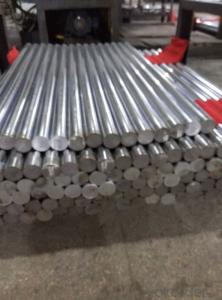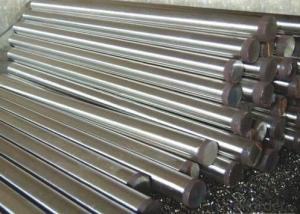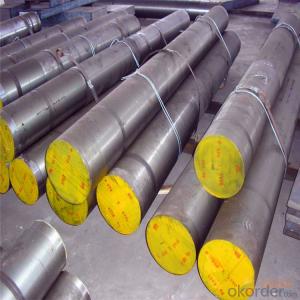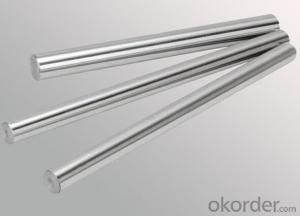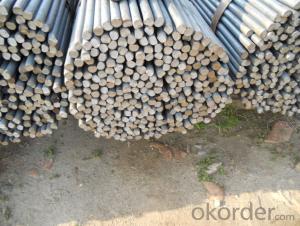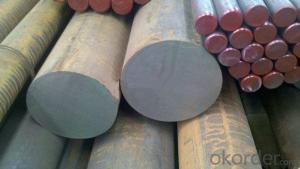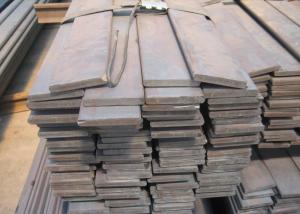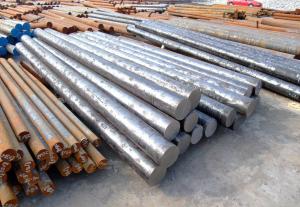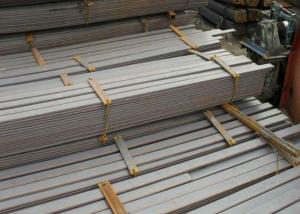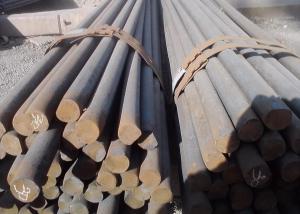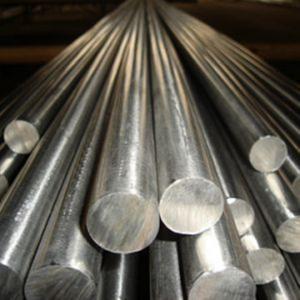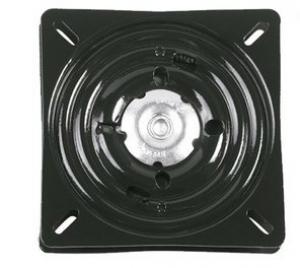Forged AISI 52100 Steel Hot Rolled Round Bar Steel
- Loading Port:
- Tianjin
- Payment Terms:
- TT OR LC
- Min Order Qty:
- 25 m.t.
- Supply Capability:
- 50000 m.t./month
OKorder Service Pledge
OKorder Financial Service
You Might Also Like
Specification
Forged AISI 52100 Steel Hot Rolled Round Bar Steel
Product Details:
1. AISI 52100/EN31/GCr 15/ DIN 1.3505/JIS SUJ2 bearing steel round bar
2.Hot rolled or forged condition, annealing , black or milled surface
3.Hardness: ≤210HBS ;
4 Hot rolled technology:EAF+LF+VD
Forged technology: EAF+LF+VD+ESR+Forging +Q T + Machined surface
5.Ultrasonic test standard: SPE1921-GR3, CLASS C/C
6.Production leadtime: 7~10 days
Chemical Composition:
C | Si | Mn | P | S | Cr | Mo |
0.95-1.05 | 0.15-0.35 | 0.25-0.45 | ≤0.025 | ≤0.025 | 1.4-1.65 | 0.1 max |
Advantage:
1)good comprehensive properties
2)good perfomance in cutting and processing after spheroids annealing
3)high hardness and homogrnization after quenching and tempering
4)high abrasive resistance and fatigue resistance
5)large amount of metal elements
6)Top quality
7)GCr15 is the most widely used bearing steel
Application:
Our products have been used in all kinds of areas, such as aviation,aerospace,navigation,nuclear energy,chemical
industry,electronic information,achine manufacture, petrochemical, automotive,instrument and meter, Communication ,
transportation, and medical instruments, etc.
Product Show:

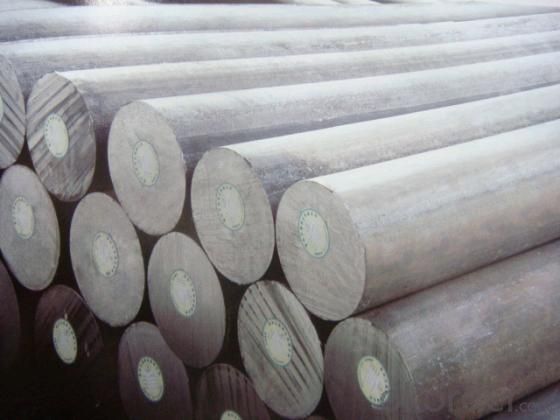
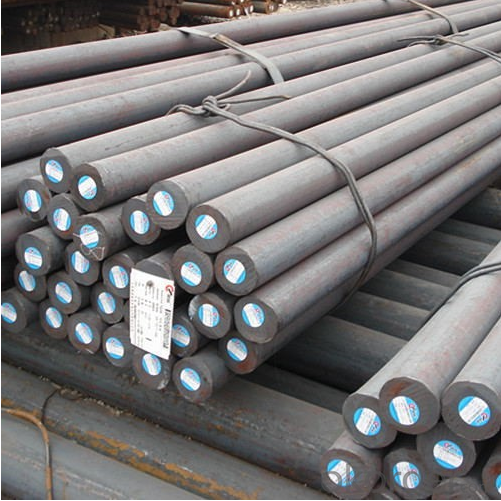
- Q: What are the key alloying elements used in special steel?
- The specific application and desired properties determine the key alloying elements used in special steel. Some commonly used alloying elements in special steel are chromium, nickel, molybdenum, vanadium, tungsten, and cobalt. To enhance the steel's hardness, wear resistance, and corrosion resistance, chromium is often added. Nickel, on the other hand, increases the steel's strength, toughness, and corrosion resistance. Molybdenum is commonly used to improve the steel's high-temperature strength, resistance to creep, and resistance to corrosion by certain chemicals. Vanadium is added to increase the steel's strength, toughness, and wear resistance, especially at high temperatures. Tungsten is another element used to enhance the steel's high-temperature strength and wear resistance. Cobalt, on the other hand, is often added to improve the steel's strength and toughness, particularly at elevated temperatures. These alloying elements are carefully chosen and added in specific proportions to achieve the desired properties for various applications, including aerospace, automotive, energy, and tooling industries. By incorporating these alloying elements, special steel can be customized to meet specific performance requirements, making it suitable for a wide range of demanding applications.
- Q: What are the specific requirements for special steel used in the marine propeller industry?
- To ensure optimal performance and durability in harsh marine environments, the marine propeller industry requires special steel that meets specific requirements. These requirements include the following: 1. Corrosion Resistance: Special steel must resist corrosion caused by constant exposure to saltwater. This prevents rust formation and maintains the propeller's integrity over time. 2. Strength and Toughness: The steel must possess high strength and toughness to withstand mechanical stresses and impacts, especially in rough sea conditions, without deforming or failing. 3. Fatigue Resistance: The steel should have excellent fatigue resistance to endure millions of load cycles without developing cracks or fractures. 4. Weldability: The steel must be easily weldable to ensure strong and reliable joints when manufacturing segmented propellers. 5. Heat Resistance: The steel needs to withstand significant heat generated by friction and propulsion forces to prevent deformation or loss of mechanical properties at high temperatures. 6. Machinability: Special steel should be easily machinable to allow for precise shaping and finishing of complex propeller blade designs. 7. Non-Magnetic Properties: To minimize interference with magnetic navigation systems and sensors used in modern ships, the steel should have low magnetic permeability. By meeting these specific requirements, the special steel used in the marine propeller industry can withstand seawater's challenging conditions, provide efficient propulsion, and maintain its structural integrity throughout the propeller's lifespan.
- Q: How does special steel perform in surface hardening applications?
- Special steel performs exceptionally well in surface hardening applications. Due to its unique composition and properties, it can undergo various surface hardening processes like carburizing or nitriding, resulting in enhanced surface hardness, wear resistance, and overall durability. This makes special steel an ideal choice for applications where high strength and improved surface properties are required, such as in automotive components, cutting tools, or industrial machinery.
- Q: How is special steel used in the textile industry?
- Special steel is commonly used in the textile industry for the production of various machinery and equipment such as needles, pins, and wire guides. These steel components are essential in processes like knitting, weaving, and sewing, as they provide durability, strength, and precision, ensuring smooth operation and quality output in textile manufacturing.
- Q: How is special steel used in the production of pressure vessels?
- Special steel is employed in the manufacturing of pressure vessels because of its distinctive characteristics that make it suitable for enduring high-pressure environments. Pressure vessels, which are containers designed to hold gases or liquids at a significantly different pressure than the surrounding atmosphere, frequently find application in industries such as oil and gas, chemical, and power generation. To guarantee the safety and dependability of these containers, the use of special steel in pressure vessel production is essential. Special steels, including carbon steels, stainless steels, and alloy steels, provide improved mechanical properties, high strength, and exceptional resistance to corrosion. These attributes are crucial for withstanding the extreme pressure conditions experienced by pressure vessels. One of the primary roles of special steel in pressure vessel production is to provide resistance against internal pressure. The steel must possess the ability to endure the force exerted by the vessel's contents without deforming or rupturing. Due to the high strength and toughness of special steels, they are capable of handling these pressures, thereby ensuring the vessel's integrity and preventing catastrophic failures. Additionally, special steel plays a vital role in preserving the structural integrity of pressure vessels. These vessels encounter various external loads, such as wind, seismic forces, and thermal expansion. The superior mechanical properties of special steel enable it to withstand these loads without significant deformation or failure, thereby ensuring the structural stability of the pressure vessel. Moreover, special steel's resistance to corrosion is crucial in pressure vessel production. Pressure vessels frequently contain corrosive substances, and the corrosive environment can lead to material degradation over time. Special steels, particularly stainless steels, offer excellent corrosion resistance, thus minimizing the risk of material deterioration and prolonging the vessel's lifespan. In conclusion, special steel is used in the production of pressure vessels due to its high strength, toughness, and corrosion resistance. These properties enable the steel to endure high-pressure conditions, maintain structural integrity, and prevent failures related to corrosion. By utilizing special steel, manufacturers of pressure vessels can ensure the safety, dependability, and longevity of these critical containers.
- Q: How does special steel contribute to the fatigue resistance of products?
- Special steel contributes to the fatigue resistance of products by providing enhanced strength, durability, and resistance to wear and tear. The unique composition and manufacturing processes of special steel result in improved mechanical properties, such as higher tensile strength and hardness, which help products withstand repeated loading and stress cycles without failure. Additionally, special steel can be engineered to have specific microstructures that enhance its resistance to fatigue, preventing the growth of cracks and ensuring longer product lifespan.
- Q: What are the main characteristics of heat-resistant steel?
- Heat-resistant steel, also known as high-temperature steel, is a type of alloy that possesses specific properties that enable it to withstand extreme temperatures without losing its mechanical strength and integrity. The main characteristics of heat-resistant steel include: 1. High resistance to thermal fatigue: Heat-resistant steel is designed to withstand cyclic heating and cooling without developing cracks or fractures. This property allows it to maintain its structural integrity even in environments with rapid temperature fluctuations. 2. Excellent creep resistance: Creep is the gradual deformation that occurs in a material when it is exposed to high temperatures over an extended period. Heat-resistant steel exhibits exceptional resistance to creep, ensuring that it retains its shape and strength even under prolonged heat exposure. 3. Retention of mechanical properties at elevated temperatures: Unlike regular steel, which can experience a significant reduction in strength and hardness at high temperatures, heat-resistant steel retains its mechanical properties even at extreme temperatures. This characteristic makes it suitable for applications in industries such as aerospace, power generation, and oil and gas. 4. Oxidation and corrosion resistance: Heat-resistant steel is highly resistant to oxidation and corrosion at elevated temperatures. It forms a protective oxide layer on its surface, preventing the underlying material from being attacked by oxygen or other corrosive elements. This property enhances the longevity and reliability of components made from heat-resistant steel. 5. High thermal conductivity: Heat-resistant steel possesses excellent thermal conductivity, allowing it to efficiently transfer heat away from its surface. This feature is particularly beneficial in applications where heat dissipation is critical, such as in heat exchangers and furnace components. 6. Low thermal expansion: Heat-resistant steel has a relatively low coefficient of thermal expansion, meaning it expands and contracts minimally when subjected to temperature changes. This characteristic ensures dimensional stability and reduces the risk of warping or distortion under thermal stress. Overall, the main characteristics of heat-resistant steel make it an ideal material for applications that involve exposure to high temperatures, such as furnace components, exhaust systems, gas turbines, and heat exchangers. Its ability to withstand extreme heat without compromising its structural integrity and mechanical properties make it a crucial material in industries where temperature resistance is paramount.
- Q: What is the maximum temperature that special steel can withstand?
- The maximum temperature that special steel can endure relies on the particular steel type employed. Special steels are engineered to possess improved qualities, including heightened resistance to heat, enabling them to endure higher temperatures in comparison to standard steels. To illustrate, certain special steels, like heat-resistant stainless steels, can withstand temperatures of approximately 1200 degrees Celsius (2200 degrees Fahrenheit). These steels are frequently utilized in scenarios where high temperatures are encountered, such as in furnaces, boilers, and exhaust systems. Different types of special steels, such as tool steels or high-speed steels, may have varying limits on their maximum temperature. These steels are commonly employed in cutting tools, molds, and machining applications, where they must maintain their hardness and strength at elevated temperatures. It should be noted that the maximum temperature that special steel can endure is also influenced by factors such as the duration of exposure to high temperature, the specific composition of the alloy, and any additional processes of heat treatment applied. Therefore, it is vital to refer to the manufacturer's specifications or seek professional advice to obtain accurate information regarding the maximum temperature limit for a specific type of special steel.
- Q: What are the challenges in welding special steel alloys?
- Welding special steel alloys poses several challenges due to their unique properties and composition. Some of the main challenges in welding special steel alloys include: 1. High melting point: Special steel alloys often have higher melting points compared to regular steel, which requires higher heat input during the welding process. This can result in difficulties in achieving proper fusion and may require specialized welding equipment and techniques. 2. Thermal expansion mismatch: Special steel alloys may have different coefficients of thermal expansion compared to the base metal or other materials being joined. This can lead to the formation of stress and distortion during welding, which can affect the structural integrity of the welded joints. 3. Sensitivity to heat: Certain special steel alloys are more susceptible to heat-affected zone (HAZ) cracking and other forms of weld defects. The high heat input during welding can cause the formation of brittle phases or precipitates, leading to reduced mechanical properties and potential weld failures. 4. Metallurgical changes: Welding special steel alloys can result in significant metallurgical changes in the base metal and the heat-affected zone. These changes include the formation of new microstructures, changes in hardness, and variations in the chemical composition. These alterations can impact the overall performance and properties of the welded joints. 5. Pre-weld and post-weld treatments: Special steel alloys often require specific pre-weld and post-weld treatments to minimize the risk of weld defects and optimize the properties of the welded joints. These treatments may include preheating, post-weld heat treatment, or the use of specialized filler metals to ensure proper weld integrity. 6. Limited availability of consumables: Special steel alloys may have limited availability of suitable consumables, such as filler metals and shielding gases, which are essential for achieving quality welds. The lack of appropriate consumables can make it challenging to find compatible materials that can provide adequate strength and corrosion resistance in the welded joints. To overcome these challenges, it is crucial to have a thorough understanding of the specific properties and requirements of the special steel alloy being welded. Proper welding techniques, including heat control, filler material selection, and post-weld treatments, should be employed to ensure high-quality welds with optimal mechanical properties and structural integrity. Additionally, collaboration with material suppliers, welding experts, and adherence to industry standards and guidelines can help address the challenges associated with welding special steel alloys effectively.
- Q: How are copper alloys used in electrical applications?
- Copper alloys are widely used in electrical applications due to their excellent conductivity and corrosion resistance. They are used to manufacture electrical wires, connectors, and busbars, ensuring efficient transmission of electricity. Additionally, copper alloys are utilized for electrical contacts and switches, as they provide good wear resistance and high electrical and thermal conductivity.
Send your message to us
Forged AISI 52100 Steel Hot Rolled Round Bar Steel
- Loading Port:
- Tianjin
- Payment Terms:
- TT OR LC
- Min Order Qty:
- 25 m.t.
- Supply Capability:
- 50000 m.t./month
OKorder Service Pledge
OKorder Financial Service
Similar products
Hot products
Hot Searches
Related keywords
